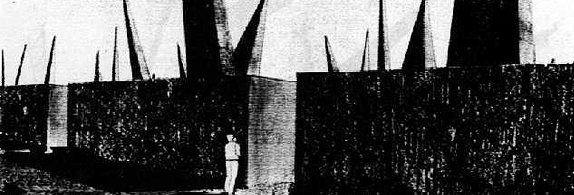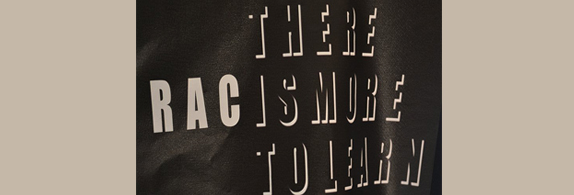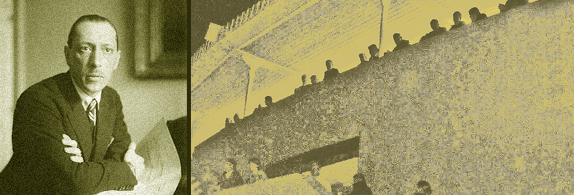WIPP: It Was Bound to Happen

A conference on Sacred Sites at the University of Cincinnati a number of years ago had a presentation by an artist who had been commissioned by the Federal government to design signage to put on top of the Waste Isolation Pilot Project (WIPP) northeast of Carlsbad, NM that would keep drilling companies and others away from the site for 10,000 years until the radioactive materials buried there a half mile underground lost much of their potency.
Ten thousand years made WIPP sound safe. But gigantic signs in the shape of ravenous teeth or jagged spikes won’t do any good now. What was supposed to be safe for millennia, unaccountably became very dangerous just a week ago.
As of February 21, Plutonium and Americium, radioactive substances associated with the production of nuclear weapons, have leaked from WIPP’s deep underground salt chambers into the atmosphere around the site and as far away as a mile and a half. And although the mainstream media has been reporting what government officials always say – that there are no public health and safety concerns -- a Department of Energy news release on February 26 said that 13 WIPP workers have tested positive for internal radiation contamination. That probably means the workers inhaled Plutonium and Americium, both of which are known to be powerful cancer-causing agents. And chances are that many more workers have inhaled them as well.
Don Hancock, of the Southwest Research and Information Center (SRIC) in Albuquerque, told the Mercury that this breaching of the 2,150 foot deep nuclear storage area was “predictable” because of the “declining safety culture” at WIPP which is marked by managers who are “overly confident” about WIPP’s inherent safety. Hancock is the long-recognized citizen expert on WIPP and other issues of nuclear safety in New Mexico.
The current manager of WIPP is Nuclear Waste Partnership, LLC, which is comprised of URS Energy and Construction, Babcock and Wilcox Technical Services, and Areva Federal Services acting as a subcontractor. They took over WIPP’s management in 2012 on a $1.3 billion five-year contract.
It needs to be said such a leak was never supposed to happen at WIPP and that it constitutes a menacing risk to public health. And it should kill forever the notion of expanding WIPP and storing high-level nuclear waste in its chambers. While the 13 workers who apparently inhaled Americium might not show signs of cancer for decades, those who are susceptible to radiation-caused tumors will know where they probably came from.
This is a terrible situation. WIPP was supposed to be the safest storage site we could find in this country, given the politics and the cost. And now it’s leaking radioactive debris into the atmosphere. Hancock and SRIC say that something happened to “apparently one or more” of what’s known as “contacted handled” waste containers in one of the WIPP underground storage rooms and that the “release of radioactive and toxic chemicals” spread through more than 3,000 feet of underground tunnels and “up the exhaust shaft into the environment….” Contact handled containers are not supposed to be dangerous, unlike containers that have to be handled by remote control.
Why would one or more of them suddenly release radioactive waste into the atmosphere? Hancock said he didn’t think it was related to the fire that occurred in one of the underground salt trucks a number of weeks earlier at WIPP. This is something else. Were the containers mislabeled, did they contain more high-powered Plutonium than they should have? Plutonium objects can’t be stored close together because they begin to generate tremendous heat. But contact handled containers are supposed to contain only things that have touched Plutonium or that have been in an environment in which Plutonium has been processed. Theoretically there’s not enough Plutonium in those containers to heat up.
It could be as long as three weeks before any human being will descend into the WIPP caverns and start to investigate the site of the release.
The SRIC website listed “what we do not know” about the release. These include:
- What caused the release.
- What was the nature of the release that allowed some contaminants to travel more than a mile and a half.
- What radionuclides in what amounts and what toxic chemicals in what amounts have been released.
- What contaminants were released into the environment before the HEPA (high-efficiency particulate absorption) filtration system was triggered.
- What contaminants in what amounts have been captured by the HEPA filters.
- What contaminants in what amounts have not been captured by the HEPA filters.
- The amounts of contamination in the WIPP underground.
- What underground decontamination will be done.
- What amount of exposure to radiation and toxic chemicals the first workers going underground will receive.
- What amount of exposure that workers on the surface have received.
- What surface decontamination will be done.
- What changes in WIPP operation, monitoring, and safety culture will be implemented.
As you can see, next to nothing is known. And we don’t know how forthcoming and transparent the WIPP managers and the DOE will be either. Will we get the same old, “oh don’t worry, little folks, nothing to worry about here”? Or will we find out what really happened and why? I worry that so much of the nation’s nuclear fixation is focused on WIPP that the DOE’s public relations magicians will go all out to try to distract and otherwise hoodwink the citizenry. It’s not hard to do, anyway, when it comes to nuclear technology. WIPP is after all the only deep geologic waste storage facility in the nation in the only state so far that actually wanted such a thing. So here we go again, one more super dangerous roller coaster ride at WIPP.
The “N Word” and Nazi Talk in Albuquerque?!

A student at UNM recently found vile “n word” graffiti scrawled near the door to her dorm room. Last year, a stick figure with a noose around its neck was found by another African American student attached to his dorm room door. And near campus two weeks ago a deli in Nob hill had anti-Semitic Nazi trash written on postal labels pasted on its door, one that read “to the kikes who will die like rats.” Such cruelties can cause victims to suffer terrible private torments and a pervading sense of violation, alienation, and loss of safety.
It’s dumbfounding when outrages like this happen, dumbfounding and heart breaking when racist threats and intimidations befall people in your hometown or at your university. The first reaction for many is to brush off such hate speech as a nasty anomaly. But as Stevie Olson wrote in the Mercury last week, all anyone has to do to take such matters seriously is to imagine how deeply worried and offended they’d be if something like that happened to one of their own children or a relative. It is a truth we must be reminded of all the time, as Margaret Randall wrote in a piece about the idea of “six degrees of separation” in the Mercury recently: What oppresses one person oppresses us all.
Racism, sexism, homophobia, or any kind of group oppression, tries to take from individual people their personality, their subjectivity, their inner moral strivings, the sacredness of their existence as human beings and defaces them instead with hideous cartoons of degradation. Most of us know this. Most of us have suffered in one way or another, either passingly or traumatically, from a form of group prejudice. But those who can tend to forget it as fast as they are able. But those who can’t, who find themselves trapped in historical patterns and cultural bigotries, might never forget nor escape. Such “accidents” of history and misfortune can happen to anyone with the turn of the wheel of luck. This all seems self-evident, but it must be said over and over again.
When a young woman at UNM is battered and abused by hateful language associated with the moral horror of slavery, it’s an atrocity to be taken personally by everyone. When a café owner is bludgeoned by language associated with the moral horror of the Holocaust, it’s an atrocity to be taken personally by everyone.
Newspapers and television reported on both incidents, and on the official responses of the university and on the candlelight vigil for the owners of the Nosh Deli. But coverage soon stopped on the pages of the papers and on the airwaves.
The coverage stopped because city and university officials did not express outrage in any sustained or useful way. These “incidents” were seen as examples of ephemeral nastiness, not as opportunities for community wide discussion and good old fashioned consciousness-raising.
Yet a rude basketball fan tosses an empty paper cup at a member of an opposing team and the boorish incident warrants a half-page photograph, considerable condemning verbiage, and vows to track down the offender of fan etiquette on the sports page, which of course it richly deserved.
The racist verbal attacks at UNM and Nob Hill could well happen again. We need to create an atmosphere in Albuquerque and on the UNM campus where racism and other forms of oppression are simply unthinkable atrocities never to be tolerated in any way. UNM’s leadership has seen too many acts of verbal violence against African Americans on campus in the last few years. They must put a stop to it. And the best way to do that is to sustain an ongoing university-wide conversation, conferences, symposia about racism and all forms of group oppression, from the highest levels of the administration to teachers and students in the classroom.
Everyone at UNM deserves to be respected and to be able to study in an environment they know is as safe as the university community can make it. And that’s not just a matter for law enforcement, but for the Regents, the President, the Provost, the Faculty Senate, the Staff Council, members of student government and graduate students. Everyone on campus needs to take racist bullying personally and see it to that UNM is known as being a university where prejudice is actively and consistently opposed and rooted out through thoughtful discussion and community awareness. How else can UNM hope to protect its own students and attract students and scholars from Asia and Latin America?
The laws of ecology apply to human groups as well as to the rest of the natural world. Everyone is connected to everyone else, just as everything in nature is connected to everything else. By addressing racism as a universal tragedy manifest in microcosm on its campus, the university can give its students, through discussion, a chance to understand deeply and personally the reality and catastrophe of group oppression and the malicious nihilism from which it arises.
As American philosopher Cornel West has written in the Cornel West Reader, “Nihilism is a natural consequence of a culture (or civilization) ruled and regulated by categories that mask manipulation, mastery, and domination of peoples and nature.” He adds that “empathy is not simply a matter of trying to imagine what others are going through, but having the will to muster enough courage to do something about it. In a way, empathy is predicated upon hope.”
Igor Stravinsky and the Santa Fe Opera

No place on the planet is unimportant. In a shrinking world like ours, every place is really no more than six people away from every place else. It was so even in l967 when the world had only slightly less than half the population it has today, a mere 3.4 billion people.
One August night at the Santa Fe Opera, the first open air version with its magnificent view west to the Jemez, a man who was born outside St. Petersburg, Russia in l882 was raptly watching a performance of Puccini’s La Boheme, my favorite opera.
At intermission I almost stepped on his foot trying to squeeze down the row to get out to the gents. I begged my apologies and then realized who he was -- the man whose music had all but changed my life over the preceding five or six years, Igor Stravinsky, creator of Petrushka, Rite of Spring, The Firebird, and dozens of other works, considered by many to be the most important composer of the 20th century. There he was in New Mexico, five years from his death, wrapped against the summer twilight chill in a huge tweed coat and heavy blue scarf, wearing a black beret, frail and almost birdlike in his face. As I tripped my way down the row, I heard him turn to the person next to him and grin “Puccini fun! Yes?”
Stravinsky in Santa Fe. What a moment. He might not have known he was in the center place of the Tewa world, or on the edge of the indigenous Hispanic heartland of North America. But perhaps that had not escaped him and his voracious curiosity. He had been in Santa Fe many times before, the first in l957 when the SF Opera opened its first season with his “The Rake’s Progress” in the repertoire. He’d been asked to watch the rehearsals and he came from Los Angeles to do it.
Now that I think more about it, I’m sure he knew where he was that night in l967. He was, as we all are everywhere, in the center of the Universe. And I was watching La Boheme not six people away from him down the row.
In those days I was reviewing opera for the Albuquerque Tribune while doubling as the guy who ran the police beat. Santa Fe was much smaller then, and Starbucks, as a caffeine source, hadn’t been invented. I’d drive home bleary-eyed, miraculously not falling asleep at the wheel by working on the review in my head. Home to the typewriter by 12:30 or so, finish the review at 3:00 a.m., up at 5:30 to get my clips and go to the cops to check the blotter. Those were the days. I’d write reviews and other things late into the night listening to Stravinsky’s Petrushka, energized into a different state of being by the fantastic music of an exiled Russian monarchist with a sweet disposition, an impatience with politics, a revolutionary aesthetic temperament, and an unstoppable work ethic supporting his inner drive for complete imaginative liberty.
The performance of La Boheme that night in l967 was but a very few weeks before the Santa Fe Opera, itself, burned to the ground. I remember walking through the ruins seeing girders twisted like loops of bubblegum. The rest of the operas that season were produced in Santa Fe’s Sweeney Gym, becoming for a time The Sweeney Opera House. But with a big boosts from Stravinsky and his reputation, money for a new opera house on the same site outside of Santa Fe near Tesuque was found and the new open-air building was completed in time for the opening of the opera season the following year.
The Santa Fe Opera has a rich history. Founded by the late John Crosby in l957, it created a repertoire that mixed beloved classics and avant garde works every season. In its 57 years of existence, it’s performed 44 American and 11 international premieres and has commissioned the creation of ten original new operas. With its innovative spirit and its apprentice program that helps train hundreds of young talented people, the Santa Fe Opera has had a significant impact on American operatic culture and its related arts.
If the center of the Universe is where you are, and if we’re all more or less neighbors in this tiny shrinking world, kindness is the necessary condition of both civility and creativity as even eccentric giants like the diminutive Igor Stravinsky knew so well. His life had been charmed by friendship and the generosity of appreciative strangers. And, in his own way, he was always willing to return the favor in New Mexico and in every other center of the world in which he worked and gave so freely of himself.
(Image credits: Racism graphic by Dominic Jacques-Bernard, Santa Fe Opera image by Colleen A. Bryant)




Responses to “Provincial Matters, 3-3-2014”